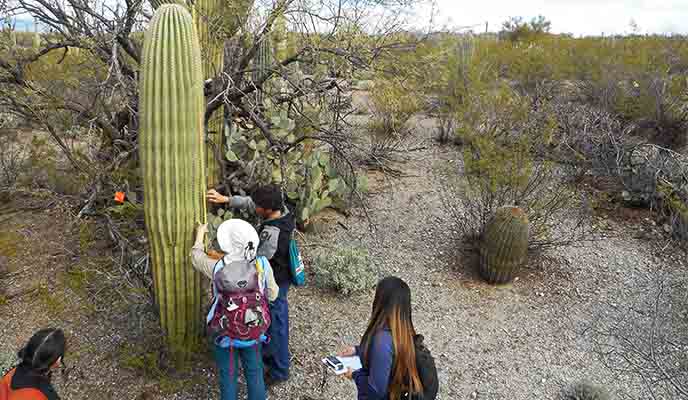Last updated: May 6, 2025
Lesson Plan
Circles and Saguaros

- Grade Level:
- Middle School: Sixth Grade through Eighth Grade
- Subject:
- Math
- Lesson Duration:
- 60 Minutes
Objective
The objective of this lesson is to help students learn how to use saguaros to find the circumference of a circle as well as how to find volume and surface area.
Background
Tucson, Arizona is home to the nation's largest cacti. The giant saguaro is the universal symbol of the American west. These majestic plants, found only in a small portion of the United States, are protected by Saguaro National Park, to the east and west of the modern city of Tucson. At Saguaro National Park, visitors from all over the world have a chance to see these enormous cacti, silhouetted by the beauty of a magnificent desert sunset.
Preparation
Familiarize yourself on saguaros.
Print Circles and Saguaro Worksheet
Materials
Download Circles and Saguaro Worksheet
Procedure
#1: As a class, watch the video on how saguaros grow in the wild.
#2: Introduce (re-introduce) circles to the students. Make sure that they are comfortable with finding the circumference of a circle. Remember that when calculating the circumference of a circle, one must first find the radius. Multilply the radius by π, then multiply this product by 2.
#3: Look at the table on the Circles and Saguaro worksheet. Notice that the values are in diameters and not radius. This will be a good time to refresh students' memory on converting diameter into radius. One can do this by dividing the diameter by 2.
#4: Let the students convert the numbers in the first column, Diameter of Circles, to radius on their own. Then, let students complete the third column, Circumference, which asks students to find the circumference using the previous information.
#5: The second part introduces students to word problems involving volume and surface area.
#6: Review with students the steps in finding the volume of a cylinder and surface area of a square. The first step in finding the volume of a cylinder is to find the radius and then square it. The second step is to multiply the number by the height of the cylinder. Finally, multiply the product by π. To find the surface area of a cube, simply multiply the base by height on one of the sides (or find the area) and then multiply the product by 6 since a cube has 6 sides.
#7: Let students work on the word problems on their own.
#8: Come together as a class and check answers.
Vocabulary
Saguaro- a giant columnar (cylindrical) cacti that is native to the Sonoran Desert
Circumference- distance around or perimeter usually of a circle; C = 2πr
Volume- the amount of space that is occupied within an object
Surface Area- the outer area of an object
Cylinder- a geometric figure with straight parallel sides and a circular top and bottom; V = πr2h
Rubric/Answer Key
Circles and Saguaros Answer Key
